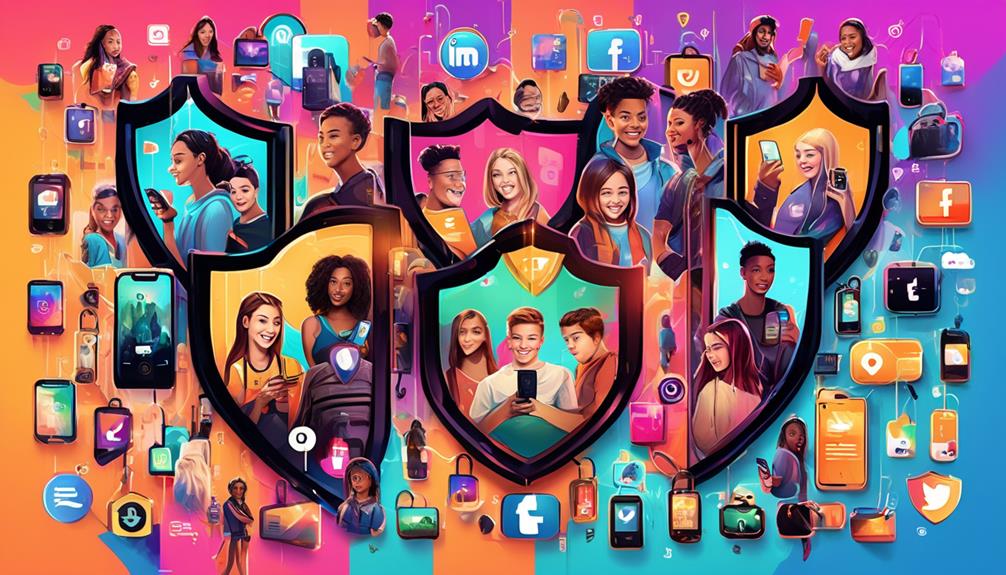Information is power in today's world. As such, youths must navigate the digital landscape with caution. Online opportunities abound, yet risks to privacy and security are ever-present. Strong passwords and avoiding suspicious emails are basics. However, the conversation is broader and requires a proactive approach.
Parents and guardians often play catch-up. They struggle to teach cybersecurity and scam prevention. These threats constantly evolve. Below are 12 essential tips. They act as armor for young netizens against internet scams. As we delve into this guidance, we must assess our current practices. It's crucial to consider what new measures we might adopt. Ensuring the safety of the youngest generation online is vital.
Understanding Online Risks

Understanding Online Risks requires critical awareness. The internet is a resource hub, yet it is laden with potential risks and scams. Each click and online interaction adds to one's digital footprint. If not managed carefully, this footprint can be traced and misused. It's not solely about shared content, but also about one's online presence.
Online predators often appear as friendly faces, hiding in cyberspace's corners. They are skilled in deception, targeting the unaware with promises. Youth must remain alert and question online interactions. Not everyone they meet online may have good intentions.
Being part of a digital community involves mutual lookout. Young individuals should report suspicious behavior confidently. They are not isolated in facing these challenges. Through self-education and peer discussion, they can traverse the internet safely. This approach helps maintain a clean digital footprint and protects personal information from malevolent forces.
Creating Strong Passwords
Creating strong passwords is essential for young netizens to protect their online presence. They must grasp the basics of password complexity. This knowledge helps prevent hackers from gaining unauthorized access. Furthermore, adopting multi-factor authentication provides an extra security layer. It significantly increases the difficulty for scammers to breach their digital defenses.
Password Complexity Essentials
In the digital age, crafting a robust password is your first line of defense against cyber threats and identity theft. Password entropy, a measure of password strength, is crucial for keeping hackers at bay. High entropy means unpredictability, making your passwords harder to crack. For added security, consider biometric options where available, as they link access directly to your unique physical traits.
To bolster your password's strength, follow these essentials:
- Mix letters, numbers, and symbols to create complexity.
- Avoid common words or phrases; instead, opt for nonsensical combinations.
- Regularly update passwords but avoid predictable patterns when changing them.
Multi-Factor Authentication Importance
Despite a strong password's value, multi-factor authentication introduces necessary extra verification steps. It ensures reliance isn't just on known elements, such as passwords, but also on possessions or personal traits. Specifically, authentication apps create temporary codes, which are more secure than passwords. These apps form an essential part of our collective defense against cyber threats.
Moreover, biometric verification offers additional security through fingerprints or facial recognition. This unique approach is exceptionally challenging for scammers to mimic. We join a community that prioritizes safety by embracing multi-factor authentication. Consequently, it helps us maintain a more secure online environment.
Managing Privacy Settings

Navigating the complex online privacy settings is essential for young individuals. As they establish their online identity, it's critical for them to understand. They should learn to configure social media settings. This will protect their personal data from unwanted scrutiny. By activating robust account security measures, they take a proactive stance. This step significantly strengthens their defense against possible online frauds.
Adjust Social Media Controls
Tightening your social media privacy settings is a crucial step in safeguarding your online presence from cyber threats and scams. Profile customization and friend vetting are essential components of this process. When you manage your settings, you're not just protecting your personal information; you're also creating a safe space where you can connect with friends and share your life comfortably.
Here's how you can strengthen your defenses:
- Review Privacy Settings: Regularly check your privacy options to control who sees your posts and personal information.
- Limit Sharing: Adjust settings to limit the visibility of your content to only trusted individuals.
- Audit Friends List: Periodically vet your connections to ensure you're only connected with people you know and trust.
Enable Strong Account Protections
Beyond adjusting your social media settings, it's crucial to enable strong account protections to further secure your digital footprint against cyber threats. This isn't just smart; it's essential for keeping you and your personal information safe. Start by setting up robust passwords and change them regularly. Don't overlook the importance of account recovery options, which can be a lifeline if you ever lose access. Ensure your recovery email and phone number are up-to-date so you're not left out in the cold.
Moreover, where available, turn on biometric verification like fingerprint or facial recognition. This tech isn't just cool—it's a powerful barrier against anyone trying to sneak into your accounts. By embracing these protections, you're not just a user; you're part of a community that values security.
Recognizing Phishing Attempts
Phishing attempts often start with an unexpected email or message, seemingly from a reputable source, designed to trick individuals into revealing sensitive information. These deceptive strategies, like email spoofing, create an illusion of trust by mimicking the email addresses of legitimate companies. Meanwhile, whaling attacks target high-profile users, such as youth influencers or budding entrepreneurs, using personalized tactics to gain access to sensitive data.
To stay safe, it's crucial to recognize the signs of a phishing attempt:
- Unexpected Requests: Legitimate organizations won't ask for personal details, like passwords or Social Security numbers, via email.
- Sense of Urgency: Scammers often create a false sense of urgency, pressuring recipients to act quickly without thinking.
- Mismatched or Suspicious Links: Hover over any links without clicking to check if the URL matches the supposed sender's website.
Safe Social Media Habits

Recognizing phishing is essential; however, safe social media habits are equally important for young users to protect their online presence. Engaging with digital communities offers a sense of belonging. Nevertheless, one should navigate these spaces with both savvy and caution. Regularly checking privacy settings is a good habit, as it controls who sees posts and personal information.
Additionally, engaging in occasional digital detoxes is wise. Stepping back from the online world allows time to reflect on one's experiences and interactions. Consequently, this break helps users reassess their social media use, ensuring it aligns with personal values and safety.
Furthermore, profile verification adds another layer of safety. It helps users identify and interact with legitimate accounts, avoiding imposters and potential scams. Importantly, young people should look for verification badges on profiles, especially when accounts offer opportunities that appear too good to be true.
Lastly, young users must remember that the internet never forgets. What is shared today might resurface years later. Therefore, keeping posts respectful and thinking twice before sharing personal details will help in creating a positive and secure digital footprint.
Avoiding Suspicious Links
As young netizens explore the web, it's vital they learn to spot phishing red flags. Consequently, they must embrace secure browsing habits. These habits protect against the hidden threats of harmful links. Understanding link safety signals is essential. These signals help differentiate reliable sources from fraudulent ones.
Identify Phishing Attempts
Understanding how to recognize phishing is vital for young web users. Scammers often employ deceptive links to hijack personal data. Phishing may include email spoofing, where the sender's identity appears authentic. Suspicious attachments are common, aiming to infiltrate your device or data.
To ensure safety, adhere to these guidelines:
Firstly, scrutinize the sender's email address; don't rely solely on the display name. Secondly, before clicking, hover over links to reveal the actual URL. Thirdly, approach emails demanding urgent action or promising extraordinary rewards with caution.
Secure Browsing Practices
Building on the skill of identifying phishing attempts, young internet users must also adopt secure browsing practices to steer clear of suspicious links. They should nurture a sense of digital camaraderie, understanding that together, they're smarter and safer against online threats. Using incognito mode can help maintain privacy, as it doesn't save browsing history or cookies, thereby reducing the risk of falling prey to harmful sites that track online behavior.
Moreover, VPN usage is crucial for youths who value their place in the digital community. A VPN encrypts internet traffic, concealing their online activities from prying eyes and making it harder for scammers to target them. By combining these tools with a vigilant mindset, they'll navigate the web more securely, as part of a community that looks out for one another.
Recognizing Link Safety Signals
Youths can bolster their defenses against cyber threats by learning to recognize the subtle yet critical signals that indicate whether a link is safe to click. A sharp eye during URL inspection can make all the difference. Here's what they should look for:
- HTTPS Protocol: Ensure the link begins with "https://"—the 's' stands for secure and means the site has safety certificates.
- Domain Authenticity: Check that the URL's domain name matches the expected website's name without odd spellings or characters.
- Padlock Icon: Look for a padlock symbol next to the URL in the browser bar, signifying a secure connection.
These checkpoints foster a sense of community in cybersecurity, empowering youths to navigate the digital landscape safely. They're not just protecting themselves; they're upholding the security of their peers by setting a vigilant example.
Handling Personal Information
When handling personal information, it's crucial for young people to navigate the digital world cautiously. They must protect their privacy and security. The threat of identity theft is significant with information sharing. It's essential to know who you're sharing with and why. Young individuals should realize that details like their full name and address are critical. Also, their phone number and financial information are pieces of a puzzle. These can give scammers the full picture of their identity.
Acting like a team, everyone plays a part in protecting each other. With the right knowledge, they can foster a data-savvy community. This community is resistant to scams. They should question requests for personal information. Additionally, they must double-check website and app authenticity. And, they should think twice before clicking links or downloading attachments. Essentially, it's about creating a security culture. In this culture, everyone feels a sense of belonging. They contribute to a safer cyber environment.
Updating Security Software

Regularly updating security software is essential for protecting young people's digital safety. These updates often include critical patches. These patches fix vulnerabilities that hackers could exploit. Consequently, by keeping software current, young individuals can better safeguard themselves. They won't be easy targets for data theft or digital disruption.
Having security software isn't enough; it must be up-to-date. Therefore, maintaining regular software updates is very important. Here's why it's crucial to keep updates in check:
Firstly, updates patch security flaws which could be exploited by malware. Secondly, they enhance features by adding new ones and improving existing tools. Thirdly, they optimize performance, ensuring smooth software operation and reducing crash risks.
Creating a schedule for updates is a wise strategy. It can involve simple weekly reminders or auto-update configurations. This routine fosters a community-minded approach to cybersecurity. As a result, everyone contributes to collective digital safety. So, by updating regularly, join the proactive group that prioritizes security. Be a proactive member of the solution.
Using Secure Connections
Beyond keeping software updated, young individuals must also ensure they're connecting to the internet through secure networks to further protect their personal information from cyber threats. Utilizing Wi-Fi encryption is a fundamental step. When they're at home or using a trusted network, they should verify that the Wi-Fi is secured with WPA3 encryption, the latest security protocol. It's like a secret handshake between their device and the router, keeping eavesdroppers out of their digital conversations.
When they're out and about, public Wi-Fi can be tempting, but it's often a playground for scammers. That's where VPN usage comes into play. A Virtual Private Network, or VPN, creates a private tunnel for their internet connection, shielding their activities from prying eyes. It's like having a personal bodyguard for their data as it travels through the digital world.
Youth should make it a habit to turn on their VPN before accessing any sensitive information or engaging in online activities that require privacy. By doing so, they join a community that values online safety and takes proactive steps to guard against cyber threats. This simple practice empowers them to take control of their digital footprint and maintain a strong defense against potential scams.
Educating on Scam Tactics

Understanding the various tactics scammers employ is crucial for young people to recognize and avoid falling victim to online deceptions. The digital world's vast reach brings countless opportunities, but it also opens the door to scammers eager to exploit the unwary. By educating themselves on common scam tactics, youths are not only protecting their own digital footprint but also contributing to a safer online community where everyone can feel secure.
Here are three scam tactics that are commonly used:
- Phishing: Scammers send emails or messages that appear to be from legitimate sources, tricking individuals into providing sensitive information.
- Impersonation: They may pretend to be someone you trust, like a family member, a friend, or a government official, to gain your confidence.
- Fake Offers: Scammers lure victims with too-good-to-be-true deals or exclusive opportunities, often creating a sense of urgency to act quickly.
Scam education isn't just about spotting the red flags; it's about understanding the psychological tricks that scammers use to create a false sense of security or urgency. Victim support is equally important, providing a network for those affected to share their experiences and learn from each other. Together, we can foster an environment where everyone feels informed, connected, and, above all, safe.
Monitoring Online Activity
Recognizing scam tactics is essential, yet monitoring online activity is crucial for youth defense against cyber threats. Consequently, parental guidance is pivotal in overseeing and influencing the digital habits of children. Importantly, this isn't about prying or breaching privacy; rather, it's about safeguarding them from the dangers of the internet.
Therefore, parents should educate their children about the significance of a clean digital footprint. Every comment, photo, or website visit potentially leaves a trace for cybercriminals. Hence, parents must encourage their kids to be cautious, particularly when clicking on links or divulging personal details.
Reporting Cyber Threats

When young internet users encounter suspicious online behavior or potential scams, it's crucial that they report these threats promptly to maintain a secure digital environment. This proactive approach ensures the safety of not only the individual but also the larger online community. Understanding where and how to report these incidents is a key step in a successful cyberbullying response and scam prevention strategy.
To effectively report cyber threats, individuals should follow these steps:
- Identify the Type of Threat: Determine if it's cyberbullying, a scam, or another type of cyber threat.
- Collect Evidence: Save or screenshot messages, emails, and any other relevant information that can help authorities investigate.
- Contact the Appropriate Party: Reach out to platform administrators, fraud hotlines, or law enforcement.
Youth should feel empowered to take action against cyber threats. Reporting such incidents is not just about self-protection; it's about fostering an online space where everyone can feel secure and supported. By using fraud hotlines and other resources designed to address these issues, young people contribute to a culture of accountability and respect in the digital world. They're not alone in this fight—there's a whole network ready to support them.
Frequently Asked Questions
How Can Youths Balance the Need for Online Socialization With Cybersecurity Measures That Seem Restrictive?
Young people can improve their digital literacy. Additionally, they should manage privacy settings. This ensures safe connections in online social spaces.
How Does the Rise of New Technologies Like Cryptocurrencies and NFTs Impact Cybersecurity Strategies for Young People?
Emerging technologies such as cryptocurrencies and NFTs necessitate revised cybersecurity approaches. Consequently, she is enhancing her knowledge of cryptocurrency and becoming aware of NFTs. This education helps safeguard her digital assets. Additionally, it ensures she remains integrated within the online community.
What Are Some Psychological Techniques Scammers Use to Manipulate Young Individuals, and How Can Youths Prepare to Counteract These?
Scammers masterfully manipulate emotions, often creating fake bonds to deceive the young. Consequently, they craft a sense of urgency, compelling quick decisions. Therefore, youths must maintain skepticism, actively pursue advice, and deliberately take time to avoid these cunning traps.
In What Ways Can Participating in Online Gaming Platforms Pose Unique Cybersecurity Risks for Youths, and What Steps Can They Take to Protect Themselves?
Online gaming exposes youths to the theft of personal information. To stay safe, they should create secure passwords. Additionally, they must avoid sharing sensitive data with others. Moreover, understanding game settings is crucial for their digital security. This approach also helps to maintain a sense of community.
How Can Young People Differentiate Between Legitimate Digital Mentorship Opportunities and Potential Scams or Exploitative Situations Online?
Young people should act as digital detectives. They need to perform due diligence. In doing so, they will navigate through numerous mentorship offers. Consequently, by carefully vetting each opportunity, they can identify authentic guidance. Additionally, they'll avoid deceitful digital risks.
Conclusion
In the digital realm, staying safe is like navigating a minefield. Young netizens can protect their digital presence effectively. They need to use strong passwords and understand privacy. Also, they should develop an ability to spot scams easily. It's imperative for them to stay alert at all times. They must report any cyber threats they encounter. It's important to remember that no scam, however sophisticated, can fool an educated mind. Therefore, being empowered in cyberspace isn't just advisable. Indeed, it's absolutely critical for one's digital survival.



